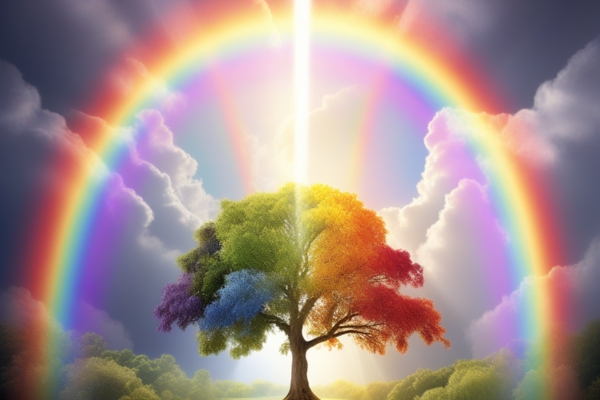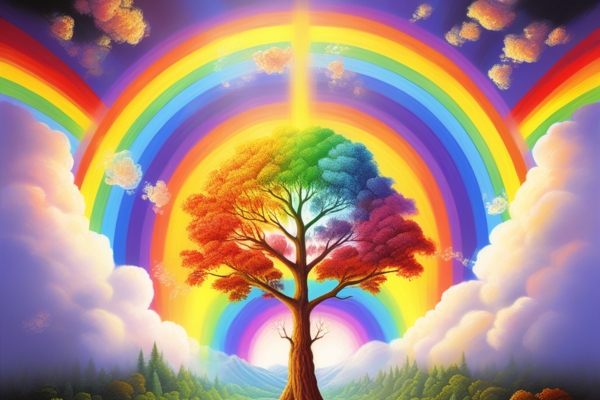For centuries, the rainbow has been a symbol of hope, beauty, and divine promise. In the Bible, the rainbow holds a special significance, serving as a reminder of God’s covenant with humanity and all living creatures on Earth. Let’s delve into the biblical meaning of the rainbow and explore its profound impact on Christian theology and symbolism.
The Biblical Account of the Rainbow (Genesis 9:8-17)
The story of the rainbow is found in the book of Genesis, after the Great Flood. God had instructed Noah to build an ark and gather pairs of every kind of living creature to save them from the impending deluge.
After the floodwaters subsided, God made a covenant with Noah, promising never again to destroy the Earth with a flood. As a sign of this everlasting covenant, God set the rainbow in the clouds, stating:
“I have set my rainbow in the clouds, and it will be the sign of the covenant between me and the earth… Whenever the rainbow appears in the clouds, I will see it and remember the everlasting covenant between God and all living creatures of every kind on the earth.” (Genesis 9:13-16, NIV)
The Hebrew word for “rainbow” used in this passage is “qesheth,” which can also mean “bow” or “arch.” This linguistic connection suggests that the rainbow was not only a beautiful natural phenomenon but also a symbolic representation of God’s protection and mercy, like a warrior’s bow laid down after a battle.
The Covenant and Its Significance
The covenant between God and Noah is of immense importance in the Bible. It represents God’s unconditional love and commitment to preserving life on Earth, even after the tragic events of the Flood. The rainbow serves as a visible reminder of this covenant, a tangible sign of God’s faithfulness and grace.
According to a study by the Pew Research Center, around 77% of Christians in the United States believe that the biblical account of the Flood is literally true, highlighting the enduring significance of this narrative and its associated symbolism.
The Rainbow as a Symbol of Hope and New Beginnings
Beyond its literal meaning, the rainbow has come to symbolize hope, renewal, and new beginnings in Christian tradition. After the darkness and destruction of the Flood, the appearance of the rainbow signified a fresh start for humanity, a chance to rebuild and live under God’s protection.
This symbolism resonates with many Christians who have experienced hardship, trials, or personal struggles. The sight of a rainbow can serve as a powerful reminder of God’s faithfulness and the promise of better days to come, much like the sun breaking through the clouds after a storm.
In a survey conducted by LifeWay Research, 63% of American adults agreed that the rainbow is a symbol of God’s promise, underscoring the enduring cultural and religious significance of this biblical imagery.
The Rainbow and God’s Attributes
The symbolism of the rainbow also reflects various attributes of God in Christian theology. Its vibrant colors are often seen as representing the majesty, creativity, and diversity of God’s creation. The arch shape of the rainbow can symbolize God’s protective embrace or the bridge between heaven and Earth.
Moreover, the fact that the rainbow appears after a storm can be interpreted as a metaphor for God’s presence and comfort during times of adversity or turmoil. Just as the rainbow emerges after the rain, God’s love and mercy shine through even in the darkest of circumstances.
According to a survey by the American Bible Society, 79% of Bible readers agreed that the Bible contains everything a person needs to live a meaningful life, further emphasizing the significance of biblical symbolism and teachings for many Christians.
The Rainbow in Christian Art and Culture
The symbolism of the rainbow has been widely represented in Christian art and culture throughout history. Numerous paintings, stained glass windows, and other artistic works have depicted the biblical account of the rainbow and its significance as a covenant sign.
One notable example is the famous fresco of the “Creation of the World” by Michelangelo in the Sistine Chapel, which features a majestic depiction of God surrounded by a rainbow-like arch. This artistic representation underscores the enduring cultural impact of the biblical symbolism of the rainbow.
Conclusion
The rainbow, as depicted in the Bible, is a powerful symbol of God’s covenant, mercy, and faithfulness. Its appearance serves as a reminder of God’s promise to preserve life on Earth and his enduring love for humanity. Beyond its literal meaning, the rainbow has come to represent hope, new beginnings, and the majesty of God’s creation.
Whether seen as a physical phenomenon or a metaphorical representation, the rainbow continues to inspire awe and wonder, reminding us of the beauty and complexity of the world we live in and the divine presence that sustains it. As Christians reflect on the biblical account of the rainbow, they are encouraged to find hope, comfort, and renewed faith in God’s unwavering promises.



